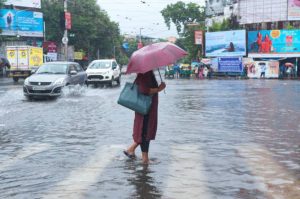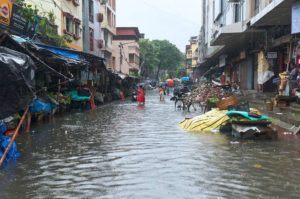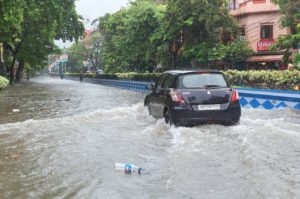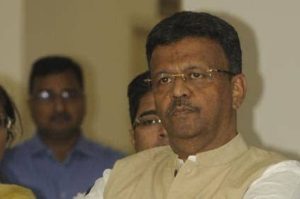Kolkata Records Wettest July in a Decade: Kolkata has just wrapped up one of its wettest Julys in recent history, with an astonishing 669 mm of rainfall recorded over the month. This figure marks the highest July rainfall in the city in the last 10 years and the second-highest in 20 years, only slightly behind the record set in 2017.
From nearly non-stop drizzles to intense downpours, residents across the city experienced at least some rain on 28 of the 31 days in July, far exceeding the average of 17.7 rainy days for the month. The data, as reported by the India Meteorological Department (IMD), suggests a significant departure from usual monsoon patterns and points toward increasingly unpredictable weather behaviour.
IMD data shows Kolkata received 669 mm of rainfall in July 2025, a 73% surplus over the monthly average of 396 mm.

Rainfall Drivers: What Caused Such an Extreme Month
The unusually high rainfall was the result of several meteorological factors converging:
- Six low-pressure systems developed over the Bay of Bengal during July, with one intensifying into a depression. These systems pumped enormous amounts of moisture over Eastern India.
- Upper-air cyclonic circulations remained active over South Bengal throughout the month.
- A persistent monsoon trough remained close to the Gangetic plains, drawing humid winds into the Kolkata region and sustaining heavy rainfall across multiple days.
This combination of synoptic factors ensured a sustained downpour over the city. The heaviest single-day rainfall came on July 25, when the city received 116.6 mm—its second-highest single-day July rain in a decade.
Source:
India Meteorological Department
Regional Meteorological Centre Kolkata


Daily Life Disrupted: Waterlogging, Traffic Chaos, and Urban Flooding
The impact of the heavy rainfall on daily life was both immediate and far-reaching:
- Waterlogging was reported in several low-lying pockets, including Salt Lake, Maniktala, Ultadanga, Park Circus, and Beliaghata.
- Traffic jams became a daily ordeal. In many places, two-wheelers stalled, auto services halted, and buses moved at a crawl.
- The Kolkata Municipal Corporation (KMC) operated more than 75 pumping stations day and night to prevent severe urban flooding, yet some neighborhoods still experienced waist-deep water.
- Many schools, offices, and informal market operations faced temporary closures, causing economic and educational setbacks.
This is not an isolated issue. The city’s outdated drainage systems, many of which were built during the colonial era, continue to be overwhelmed by modern rainfall volumes.
Mayor Firhad Hakim acknowledged in a statement that “our city’s infrastructure has not been able to keep up with the changing climate, and we are working on it.”




A Broader Pattern: Changing Monsoon and Rising Extremes
Kolkata’s July rainfall is part of a larger pattern of climate change-induced weather volatility. Experts and climatologists have pointed out that:
- India is seeing more extreme rainfall events, especially during the monsoon period.
- While total rainfall may not be increasing drastically, it is falling in shorter, more intense bursts, overwhelming urban systems.
- Rising surface sea temperatures in the Bay of Bengal are contributing to the formation of stronger and more frequent low-pressure systems.
Relevant Reading:
Climate Trends Report – India, 2024 (Centre for Science and Environment)
Indian Institute of Tropical Meteorology – Monsoon Studies


Civic Response and Long-Term Planning
In response to this year’s monsoon excess, the Kolkata Municipal Corporation has begun prioritizing several key initiatives:
- Upgrading pumping stations and drainage networks, especially in flood-prone zones like Behala, Jadavpur, and Garden Reach.
- Collaborating with IIT Kharagpur and other institutions to develop AI-based flood prediction models.
- Urban wetland restoration projects to increase water absorption capacity in the eastern fringes of the city.
However, civic activists argue that much more needs to be done. Projects often move slowly, and poor maintenance of canals and sewers reduces efficiency during peak rainfall hours.
“Most of our canals are choked with plastic and construction waste. This is a disaster waiting to happen every year,” said an environmental expert from South Kolkata.
Agricultural and Economic Impacts
Beyond urban life, the heavy rainfall has had a ripple effect on the region’s economy:
- Rice, jute, and paddy cultivation in nearby districts like North 24 Parganas and Hooghly have benefited from the rain, but excessive water has also flooded many farmlands, damaging saplings.
- Informal workers and daily wage earners in Kolkata reported a drop in workdays, with fewer customers and more sheltering from the rain.
- Local businesses, especially roadside vendors and food stalls, saw losses due to reduced footfall and soggy conditions.
For many small entrepreneurs, the unrelenting weather meant closing shops early, delaying deliveries, or paying for water damage repairs.
Kolkata Records Wettest July in a Decade: Temperature Dip Offers Brief Relief
Interestingly, the heavy rains kept day temperatures below average throughout July. IMD recorded an average high temperature of 30.3°C—about 4.2°C below normal. Nights were also slightly cooler than average.
While this brought temporary relief from summer heat, it also increased humidity, leading to discomfort, especially indoors.
Forecast for August: Will the Rain Continue?
According to the IMD’s extended range forecast, rainfall activity over Kolkata is expected to slow down in the first half of August. However:
- Scattered rain will continue in South Bengal, particularly during afternoon hours.
- North Bengal districts such as Jalpaiguri, Darjeeling, and Alipurduar are likely to witness heavier rainfall due to orographic effects and continuing moisture inflow from the Bay.
The IMD has not forecast any new low-pressure formations as of now but remains alert to developments in the Bay of Bengal.
Source:
India Meteorological Department – Extended Forecast
Long-Term Outlook: Need for Climate Resilience
Experts warn that unless Kolkata begins treating climate resilience as a civic and policy priority, the situation could worsen in coming years:
- Peri-urban areas are expanding without adequate drainage planning.
- Encroachment on wetlands and ponds reduces the city’s ability to naturally absorb excess rainfall.
- Rising impervious surfaces—like concrete roads and buildings—exacerbate runoff and reduce groundwater recharge.
A more comprehensive monsoon action plan must include:
- Investment in green infrastructure
- Public awareness about plastic disposal
- Decentralized water management solutions
- Improved early warning systems
Conclusion: A Wake-Up Call for Kolkata
This July has served as a powerful reminder that the climate is changing, and Kolkata is vulnerable to its effects. The record rainfall of 2025 may become a more frequent occurrence unless both citizens and city authorities act together to build resilience and adapt urban systems.
Kolkata is no stranger to rain, but the intensity and frequency of such events are shifting. From the clogged streets of Salt Lake to the waterlogged alleys of Behala, every corner of the city is feeling the impact.
How the city responds in the coming years will determine whether it merely survives the monsoon or learns to thrive despite it.
Further Reading and Resources:
- World Bank: Climate Change and Urban Flooding in South Asia
- NASA Earth Observatory: Rainfall Trends in India
- IPCC AR6 Report – South Asia Regional Impacts
Also read: Home | Channel 6 Network – Latest News, Breaking Updates: Politics, Business, Tech & More

